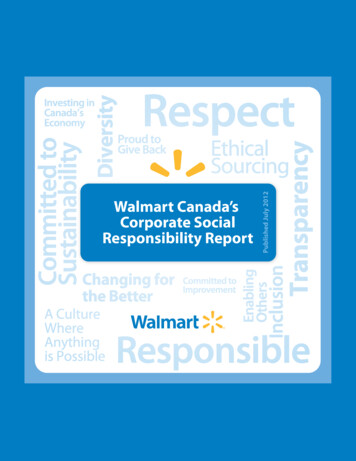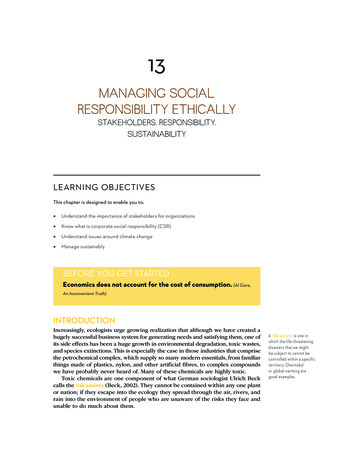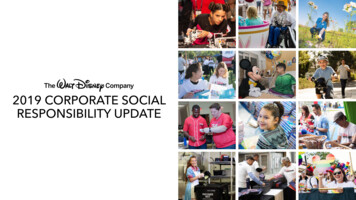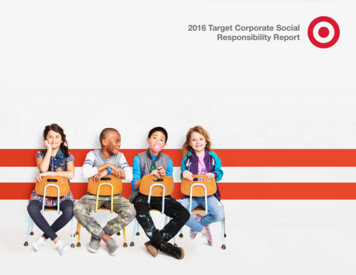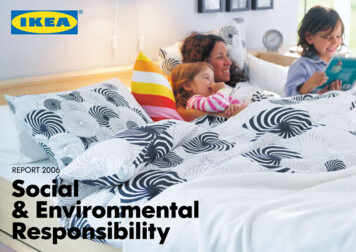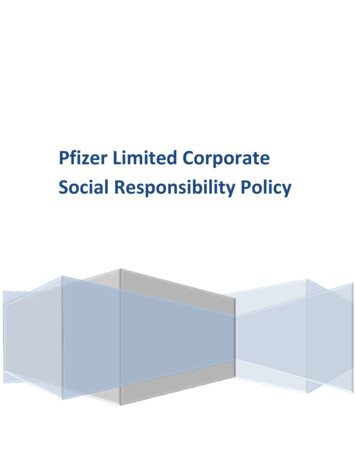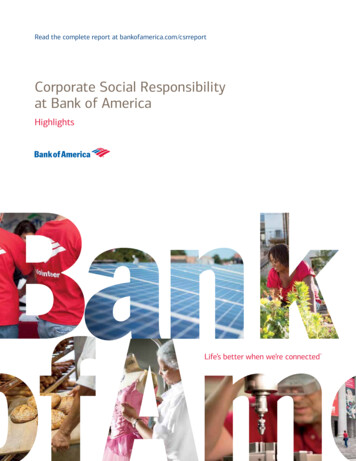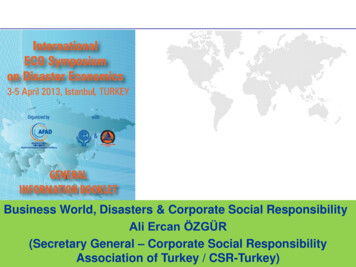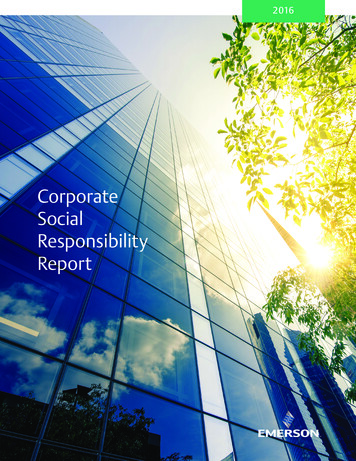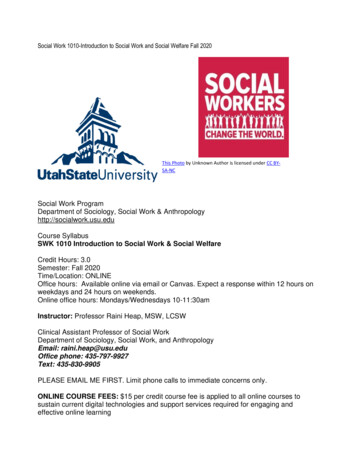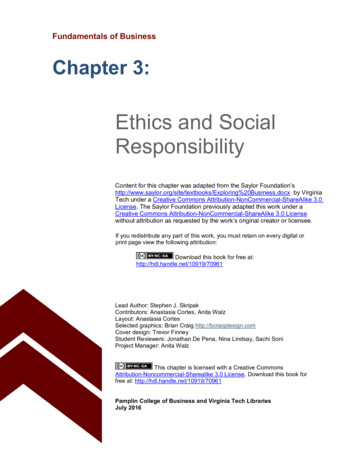
Transcription
Fundamentals of BusinessChapter 3:Ethics and SocialResponsibilityContent for this chapter was adapted from the Saylor /Exploring%20Business.docx by VirginiaTech under a Creative Commons Attribution-NonCommercial-ShareAlike 3.0License. The Saylor Foundation previously adapted this work under aCreative Commons Attribution-NonCommercial-ShareAlike 3.0 Licensewithout attribution as requested by the work’s original creator or licensee.If you redistribute any part of this work, you must retain on every digital orprint page view the following attribution:Download this book for free at:http://hdl.handle.net/10919/70961Lead Author: Stephen J. SkripakContributors: Anastasia Cortes, Anita WalzLayout: Anastasia CortesSelected graphics: Brian Craig http://bcraigdesign.comCover design: Trevor FinneyStudent Reviewers: Jonathan De Pena, Nina Lindsay, Sachi SoniProject Manager: Anita WalzThis chapter is licensed with a Creative CommonsAttribution-Noncommercial-Sharealike 3.0 License. Download this book forfree at: http://hdl.handle.net/10919/70961Pamplin College of Business and Virginia Tech LibrariesJuly 2016
Chapter 3Ethics and Social ResponsibilityLearning Objectives1) Define business ethics and explain what it means to act ethicallyin business.2) Explain why we study business ethics.3) Identify ethical issues that you might face in business, such asinsider trading, conflicts of interest, and bribery, and explainrationalizations for unethical behavior.4) Identify steps you can take to maintain your honesty and integrityin a business environment.5) Define corporate social responsibility and explain howorganizations are responsible to their stakeholders, includingowners, employees, customers, and the community.6) Discuss how you can identify an ethical organization, and howorganizations can prevent behavior like sexual harassment.7) Learn how to avoid an ethical lapse, and why you should notrationalize when making decisions.56Download this book for free at:http://hdl.handle.net/10919/70961Chapter 3
Introduction“Mommy, Why Do You Have to Go to Jail?”The one question Betty Vinson would have preferred to avoid is “Mommy, why do youhave to go to jail?”1 Vinson graduated with an accounting degree from Mississippi State andmarried her college sweetheart. After a series of jobs at small banks, she landed a mid-levelaccounting job at WorldCom, at the time still a small long-distance provider. Sparked by thetelecom boom, however, WorldCom soon became a darling of Wall Street, and its stock pricesoared. Now working for a wildly successful company, Vinson rounded out her life by readinglegal thrillers and watching her daughter play soccer.Her moment of truth came in mid-2000, when company executives learned that profitshad plummeted. They asked Vinson to make some accounting adjustments to boost income by 828 million. Vinson knew that the scheme was unethical (at the very least) but she gave inand made the adjustments. Almost immediately, she felt guilty and told her boss that she wasquitting. When news of her decision came to the attention of CEO Bernard Ebbers and CFOScott Sullivan, they hastened to assure Vinson that she’d never be asked to cook any morebooks. Sullivan explained it this way: “We have planes in the air. Let’s get the planes landed.Once they’ve landed, if you still want to leave, then leave. But not while the planes are in theair.”2 Besides, she’d done nothing illegal, and if anyone asked, he’d take full responsibility. SoVinson decided to stay. After all, Sullivan was one of the top CFOs in the country; at age thirtyseven, he was already making 19 million a year.3 Who was she to question his judgment?4Six months later, Ebbers and Sullivan needed another adjustment—this time for 771million. This scheme was even more unethical than the first: it entailed forging dates to hidethe adjustment. Pretty soon, Vinson was making adjustments on a quarterly basis—first for 560 million, then for 743 million, and yet again for 941 million. Eventually, Vinson hadjuggled almost 4 billion, and before long, the stress started to get to her: she had troublesleeping, lost weight, and withdrew from people at work. She decided to hang on when she gota promotion and a 30,000 raise.Chapter 3Download this book for free at:http://hdl.handle.net/10919/7096157
By spring 2002, however, it was obvious that adjusting the books was business as usualat WorldCom. Vinson finally decided that it was time to move on, but, unfortunately, an internalauditor had already put two and two together and blown the whistle. The Securities andExchange Commission charged WorldCom with fraud amounting to 11 billion—the largest inU.S. history. Seeing herself as a valuable witness, Vinson was eager to tell what she knew.The government, however, regarded her as more than a mere witness. When she was nameda co-conspirator, she agreed to cooperate fully and pleaded guilty to criminal conspiracy andsecurities fraud. But she won’t be the only one doing time: Scott Sullivan will be in jail for fiveyears, and Bernie Ebbers will be locked up for twenty-five years. Both maintain that they areinnocent.5So where did Betty Vinson, mild-mannered midlevel executive and mother, go wrong?How did she manage to get involved in a scheme that not only bilked investors out of billionsbut also cost seventeen thousand people their jobs?6 Ultimately, of course, we can only guess.Maybe she couldn’t say no to her bosses; perhaps she believed that they’d take fullresponsibility for her accounting “adjustments.” Possibly she was afraid of losing her job ordidn’t fully understand the ramifications of what she was doing. What we do know is that shedisgraced herself and went to jail.7The WorldCom situation is not an isolated incident.Perhaps you have heard of Bernie Madoff, founder of Bernard L.Figure 3.1: Bernie Madoff’smug shotMadoff Investment Securities and former chairman of theNASDAQ stock exchange.8 Madoff is alleged to have run a giantPonzi scheme9 that cheated investors of up to 65 billion. Hiswrongdoings won him a spot at the top of Time Magazine’s Top10 Crooked CEOs. According to the SEC charges, Madoffconvinced investors to give him large sums of money. In return,he gave them an impressive 8 percent to 12 percent return a year.But Madoff never really invested their money. Instead, he kept itfor himself. He got funds to pay the first investors their return (ortheir money back if they asked for it) by bringing in new investors. Everything was goingsmoothly until the fall of 2008, when the stock market plummeted and many of his investorsasked for their money. As he no longer had it, the game was over and he had to admit that the58Download this book for free at:http://hdl.handle.net/10919/70961Chapter 3
whole thing was just one big lie. Thousands of investors, including many of his wealthy friends,not-so-rich retirees who trusted him with their life savings, and charitable foundations, werefinancially ruined. Those harmed by Madoff either directly or indirectly were likely pleasedwhen he was sentenced to jail for one-hundred and fifty years.What is Business Ethics?The Idea of Business EthicsIt’s in the best interest of a company to operate ethically. Trustworthy companies arebetter at attracting and keeping customers, talented employees, and capital. Those tainted byquestionable ethics suffer from dwindling customer bases, employee turnover, and investormistrust.Let’s begin this section by addressing this question: What can individuals,organizations, and government agencies do to foster an environment of ethical behavior inbusiness? First, of course, we need to define the term.What Is Ethics?You probably already know what it means to be ethical: to know right from wrong andto know when you’re practicing one instead of the other. We can say that business ethics isthe application of ethical behavior in a business context. Acting ethically in business meansmore than simply obeying applicable laws and regulations: It also means being honest, doingno harm to others, competing fairly, and declining to put your own interests above those ofyour company, its owners, and its workers. If you’re in business you obviously need a strongsense of what’s right and wrong. You need the personal conviction to do what’s right, even if itmeans doing something that’s difficult or personally disadvantageous.Why Study Ethics?Ideally, prison terms, heavy fines, and civil suits would discourage corporatemisconduct, but, unfortunately, many experts suspect that this assumption is a bit optimistic.Whatever the condition of the ethical environment in the near future, one thing seems clear:Chapter 3Download this book for free at:http://hdl.handle.net/10919/7096159
the next generation entering business—which includes most of you—will find a world muchdifferent than the one that waited for the previous generation. Recent history tells us in nouncertain terms that today’s business students, many of whom are tomorrow’s businessleaders, need a much sharper understanding of the difference between what is and isn’tethically acceptable. As a business student, one of your key tasks is learning how to recognizeand deal with the ethical challenges that will confront you. Asked what he looked for in a newhire, Warren Buffet, the world’s most successful investor, replied: “I look for three things. Thefirst is personal integrity, the second is intelligence, and the third is a high energy level.” Hepaused and then added: “But if you don’t have the first, the second two don’t matter.”10Identifying Ethical Issues and DilemmasEthical issues are the difficult social questions that involve some level of controversyover what is the right thing to do. Environmental protection is an example of a commonlydiscussed ethical issue, because there can be tradeoffs between environmental and economicfactors.Ethical dilemmas are situations in which it is difficult for an individual to makedecisions either because the right course of action is unclear or carries some potentialnegative consequences for the person or people involved.Make no mistake about it: when you enter the business world, you’ll find yourself insituations in which you’ll have to choose the appropriate behavior. How, for example, wouldyou answer questions like the following?1) Is it OK to accept a pair of sports tickets from a supplier?2) Can I buy office supplies from my brother-in-law?3) Is it appropriate to donate company funds to a local charity?4) If I find out that a friend is about to be fired, can I warn her?60Download this book for free at:http://hdl.handle.net/10919/70961Chapter 3
Obviously, the types of situations are numerous andvaried. Fortunately, we can break them down into a fewFigure 3.2: How to maintainhonesty and integritybasic categories: issues of honesty and integrity, conflicts ofinterest and loyalty, bribes versus gifts, and whistle-blowing.Let’s look a little more closely at each of these categories.Issues of Honesty and IntegrityMaster investor Warren Buffet once told a group ofbusiness students the following: “I cannot tell you thathonesty is the best policy. I can’t tell you that if you behavewith perfect honesty and integrity somebody somewherewon’t behave the other way and make more money. Buthonesty is a good policy. You’ll do fine, you’ll sleep well atnight and you’ll feel good about the example you are settingfor your coworkers and the other people who care aboutyou.”11If you work for a company that settles for itsemployees’ merely obeying the law and following a fewinternal regulations, you might think about moving on. Ifyou’re being asked to deceive customers about the qualityor value of your product, you’re in an ethically unhealthyenvironment.Think about this story:“A chef put two frogs in a pot of warm soupwater. The first frog smelled the onions, recognizedthe danger, and immediately jumped out. Thesecond frog hesitated: The water felt good, and he decided to stay and relax for aminute. After all, he could always jump out when things got too hot (so to speak).As the water got hotter, however, the frog adapted to it, hardly noticing thechange. Before long, of course, he was the main ingredient in frog-leg soup.”12Chapter 3Download this book for free at:http://hdl.handle.net/10919/7096161
So, what’s the moral of the story? Don’t sit around in an ethically toxic environment andlose your integrity a little at a time; get out before the water gets too hot and your options haveevaporated. Fortunately, a few rules of thumb can guide you.We’ve summed them up in Figure 3.2 on the previous page.Conflicts of InterestConflicts of interest occur when individuals must choose between taking actions thatpromote their personal interests over the interests of others or taking actions that don’t. Aconflict can exist, for example, when an employee’s own interests interfere with, or have thepotential to interfere with, the best interests of the company’s stakeholders (management,customers, and owners). Let’s say that you work for a company with a contract to cater eventsat your college and that your uncle owns a local bakery. Obviously, this situation could create aconflict of interest (or at least give the appearance of one—which is a problem in itself). Whenyou’re called on to furnish desserts for a luncheon, you might be tempted to send somebusiness your uncle’s way even if it’s not in the best interest of your employer. What shouldyou do? You should disclose the connection to your boss, who can then arrange things so thatyour personal interests don’t conflict with the company’s.The same principle holds that an employee shouldn’t use private information about anemployer for personal financial benefit. Say that you learn from a coworker at yourpharmaceutical company that one of its most profitable drugs will be pulled off the marketbecause of dangerous side effects. The recall will severely hurt the company’s financialperformance and cause its stock price to plummet. Before the news becomes public, you sellall the stock you own in the company. What you’ve done is called insider trading – acting oninformation that is not available to the general public, either by trading on it or providing it toothers who trade on it. Insider trading is illegal, and you could go to jail for it.Conflicts of LoyaltyYou may one day find yourself in a bind between being loyal either to your employer orto a friend or family member. Perhaps you just learned that a coworker, a friend of yours, isabout to be downsized out of his job. You also happen to know that he and his wife are gettingready to make a deposit on a house near the company headquarters. From a work standpoint,62Download this book for free at:http://hdl.handle.net/10919/70961Chapter 3
you know that you shouldn’t divulge the information. From a friendship standpoint, though, youfeel it’s your duty to tell your friend. Wouldn’t he tell you if the situation were reversed? So whatdo you do? As tempting as it is to be loyal to your friend, you shouldn’t tell. As an employee,your primary responsibility is to your employer. You might be able to soften your dilemma byconvincing a manager with the appropriate authority to tell your friend the bad news before heputs down his deposit.Bribes versus GiftsIt’s not uncommon in business to give and receive small gifts of appreciation, but whenis a gift unacceptable? When is it really a bribe?There’s often a fine line between a gift and a bribe. The following information may helpin drawing it, because it raises key issues in determining how a gesture should be interpreted:the cost of the item, the timing of the gift, the type of gift, and the connection between the giverand the receiver. If you’re on the receiving end, it’s a good idea to refuse any item that’s overlygenerous or given for the purpose of influencing a decision. Because accepting even smallgifts may violate company rules, always check on company policy.JCPenney’s “Statement of Business Ethics,” for instance, states that employees can’taccept any cash gifts or any noncash gifts except those that have a value below 50 and thatare generally used by the giver for promotional purposes. Employees can attend paid-forbusiness functions, but other forms of entertainment, such as sports events and golf outings,can be accepted only if it’s practical for the Penney’s employee to reciprocate. Trips of severaldays can’t be accepted under any circumstances.13Whistle-BlowingAs we’ve seen, the misdeeds of Betty Vinson and her accomplices at WorldCom didn’tgo undetected. They caught the eye of Cynthia Cooper, the company’s director of internalauditing. Cooper, of course, could have looked the other way, but instead she summoned upthe courage to be a whistle-blower—an individual who exposes illegal or unethical behavior inan organization. Like Vinson, Cooper had majored in accounting at Mississippi State and wasa hard-working, dedicated employee. Unlike Vinson, however, she refused to be bullied by herboss, CFO Scott Sullivan. In fact, she had tried to tell not only Sullivan but also auditors fromChapter 3Download this book for free at:http://hdl.handle.net/10919/7096163
the Arthur Andersen accounting firm that there was a problem with WorldCom’s books. Theauditors dismissed her warnings, and when Sullivan angrily told her to drop the matter, shestarted cleaning out her office. But she didn’t relent. She and her team worked late each night,conducting an extensive, secret investigation. Two months later, Cooper had evidence to taketo Sullivan, who told her once again to back off. Again, however, she stood up to him, andthough she regretted the consequences for her WorldCom coworkers, she reported thescheme to the company’s board of directors. Within days, Sullivan was fired and the largestaccounting fraud in history became public.14As a result of Cooper’s actions, executives came clean about the company’s financialsituation. The conspiracy of fraud was brought to an end, and though public disclosure ofWorldCom’s problems resulted in massive stock-price declines and employee layoffs, investorand employee losses would have been greater without Cooper’s intervention. Even thoughCooper did the right thing, and landed on the cover of Time magazine for it, the experiencewasn’t exactly gratifying.A lot of people applauded her action, but many coworkers shunned her; some evenblamed her for the company’s troubles.15Whistle-blowing is sometimes career suicide. A survey of two hundred whistle-blowersconducted by the National Whistleblower Center found that half were fired for blowing thewhistle.16 Even those who keep their jobs can experience repercussions. As long as they stay,some will treat them (as one whistle-blower put it) “like skunks at a picnic”; if they leave, theymay be blackballed in the industry.17 On a positive note, new Federal laws have been passedwhich are intended to protect whistle-blowers.For her own part, Cynthia Cooper doesn’t regret what she did. As she told a group ofstudents at Mississippi State: “Strive to be persons of honor and integrity. Do not allow yourselfto be pressured. Do what you know is right even if there may be a price to be paid.”18 If yourcompany tells employees to do whatever it takes, push the envelope, look the other way, and“be sure that we make our numbers,” you have three choices: go along with the policy, try tochange things, or leave. If your personal integrity is part of the equation, you’re probably downto the last two choices.1964Download this book for free at:http://hdl.handle.net/10919/70961Chapter 3
Corporate Social ResponsibilityCorporate social responsibility refers to the approach that an organization takes inbalancing its responsibilities toward different stakeholders when making legal, economic,ethical, and social decisions. Remember that we previously defined stakeholders as thosewith a legitimate interest in the success or failure of the business and the policies it adopts.The term social responsibility refers to the approach that an organization takes in balancing itsresponsibilities toward their various stakeholders.What motivates companies to be “socially responsible”? We hope it’s because theywant to do the right thing, and for many companies, “doing the right thing” is a key motivator.The fact is, it’s often hard to figure out what the “right thing” is: what’s “right” for one group ofstakeholders isn’t necessarily just as “right” for another. One thing, however, is certain:companies today are held to higher standards than ever before. Consumers and other groupsconsider not only the quality and price of a company’s products but also its character. If toomany groups see a company as a poor corporate citizen, it will have a harder time attractingqualified employees, finding investors, and selling its products. Good corporate citizens, bycontrast, are more successful in all these areas.Figure 3.3 presents a model of corporate responsibility based on a company’srelationships with its stakeholders. In this model, the focus is on managers—not owners—asthe principals involved in these relationships. Owners are the stakeholders who invest riskcapital in the firm in expectation of a financial return. Other stakeholders include employees,suppliers, and the communities in which the firm does business. Proponents of this modelhold that customers, who provide the firm with revenue, have a special claim on managers’attention. The arrows indicate the two-way nature of corporation-stakeholder relationships: Allstakeholders have some claim on the firm’s resources and returns, and management’s job is tomake decisions that balance these claims.20Chapter 3Download this book for free at:http://hdl.handle.net/10919/7096165
Let’s look at some of the ways in which companies can be “socially responsible” inconsidering the claims of various stakeholders.Figure 3.3: Management’s relationships with stakeholdersOwnersOwners invest money in companies. In return, the people who run a company have aresponsibility to increase the value of owners’ investments through profitable operations.Managers also have a responsibility to provide owners (as well as other stakeholders havingfinancial interests, such as creditors and suppliers) with accurate, reliable information aboutthe performance of the business. Clearly, this is one of the areas in which WorldCommanagers fell down on the job. Upper-level management purposely deceived shareholders bypresenting them with fraudulent financial statements66Download this book for free at:http://hdl.handle.net/10919/70961Chapter 3
ManagersManagers have what is known as a fiduciary responsibility to owners: they’reresponsible for safeguarding the company’s assets and handling its funds in a trustworthymanner. Yet managers experience what is called the agency problem; a situation in which theirbest interests do not align with those of the owners who employ them. To enforce managers’fiduciary responsibilities for a firm’s financial statements and accounting records, theSarbanes-Oxley Act of 2002 requires CEOs and CFOs to attest to their accuracy. The law alsoimposes penalties on corporate officers, auditors, board members, and any others who commitfraud. You’ll learn more about this law in your accounting and business law courses.EmployeesCompanies are responsible for providing employees with safe, healthy places towork—as well as environments that are free from sexual harassment and all types ofdiscrimination. They should also offer appropriate wages and benefits. In the followingsections, we’ll take a closer look at these areas of corporate responsibility.Wages and BenefitsAt the very least, employers must obey laws governing minimum wage and overtimepay. A minimum wage is set by the federal government, though states can set their own ratesas long as they are higher. The current federal rate, for example, is 7.25, while the rate inmany states is far higher.21 By law, employers must also provide certain benefits—socialsecurity (retirement funds), unemployment insurance (protects against loss of income in caseof job loss), and workers’ compensation (covers lost wages and medical costs in case of onthe-job injury). Most large companies pay most of their workers more than minimum wage andoffer broader benefits, including medical, dental, and vision care, as well as savings programs,in order to compete for talent.Chapter 3Download this book for free at:http://hdl.handle.net/10919/7096167
Safety and HealthThough it seems obvious that companies should guard workers’ safety and health,some simply don’t. For over four decades, for example, executives at Johns Manvillesuppressed evidence that one of its products, asbestos, was responsible for the deadly lungdisease developed by many of its workers.22 The company concealed chest X- rays fromstricken workers, and executives decided that it was simply cheaper to pay workers’compensation claims than to create a saferwork environment. A New Jersey court wasquite blunt in its judgment: Johns Manville, itFigure 3.4: Workplace deaths by event orexposure, 2014.held, had made a deliberate, cold-bloodeddecision to do nothing to protect at-riskworkers, in blatant disregard of their rights.23About four in one hundred thousandU.S. workers die in workplace “incidents” eachyear. The Department of Labor categorizesdeaths caused by conditions like those atJohns Manville as “exposure to harmfulsubstances or environments.” How prevalentis this condition as a cause of workplacedeaths? See Figure 3.4, “Workplace Deathsby Event or Exposure, 2014”, which breaks down workplace fatalities by cause. Some jobs aremore dangerous than others. For a comparative overview based on workplace deaths byoccupation, see Figure 3.5.Fortunately for most people, things are far better than they were at Johns Manville.Procter & Gamble (P&G), for example, considers the safety and health of its employeesparamount and promotes the attitude that “Nothing we do is worth getting hurt for.” With nearlyone hundred thousand employees worldwide, P&G uses a measure of worker safety called“total incident rate per employee,” which records injuries resulting in loss of consciousness,time lost from work, medical transfer to another job, motion restriction, or medical treatmentbeyond first aid. The company attributes the low rate of such incidents—less than one incidentper hundred employees—to a variety of programs to promote workplace safety.2468Download this book for free at:http://hdl.handle.net/10919/70961Chapter 3
Figure 3.5: Workplace deaths by occupation, 2014.IndustryConstructionTransportation and WarehousingAgriculture, Forestry, and FishingGovernmentProfessional and Business ServicesManufacturingRetail TradeLeisure and HospitalityMining, Quarrying, and Natural Gas Extraction% of TotalWorkplace Deaths19%16%12%9%9%7%6%4%4%CustomersThe purpose of any business is to satisfy customers, who reward businesses by buyingtheir products. Sellers are also responsible—both ethically and legally—for treating customersfairly. The rights of consumers were first articulated by President John F. Kennedy in 1962when he submitted to Congress a presidential message devoted to consumer issues.25Kennedy identified four consumer rights:1) The right to safe products. A company should sell no product that it suspects ofbeing unsafe for buyers. Thus, producers have an obligation to safety-test productsbefore releasing them for public consumption. The automobile industry, for example,conducts extensive safety testing before introducing new models (though recallsremain common).2) The right to be informed about a product. Sellers should furnish consumers withthe product information that they need to make an in- formed purchase decision.That’s why pillows have labels identifying the materials used to make them, forinstance.3) The right to choose what to buy. Consumers have a right to decide whichproducts to purchase, and sellers should let them know what their options are.Pharmacists, for example, should tell patients when a prescription can be filled witha cheaper brand-name or generic drug. Telephone companies should explainalternative calling plans.Chapter 3Download this book for free at:http://hdl.handle.net/10919/7096169
4) The right to be heard. Companies must tell customers how to contact them withcomplaints or concerns. They should also listen and respond.Companies share the responsibility for the legal and ethical treatment of consumerswith several government agencies: the Federal Trade Commission (FTC), which enforcesconsumer-protection laws; the Food and Drug Administration (FDA), which oversees thelabeling of food products; and the Consumer Product Safety Commission, which enforceslaws protecting consumers from the risk of product-related injury.CommunitiesFor obvious reasons, most communities see getting a new business as an asset andview losing one—especially a large employer—as a detriment. After all, the economic impactof business activities on local communities is substantial: They provide jobs, pay taxes, andsupport local education, health, and recreation programs. Both big and small businessesdonate funds to community projects, encourage employees to volunteer their time, and donateequipment and products for a variety of activities. Larger companies can make greaterfinancial contributions. Let’s start by taking a quick look at the philanthropic activities of a fewU.S. corporations.PhilanthropyMany large corporations support various charities, an activity called philanthropy.Some donate a percentage of sales or profits to worthwhile causes. Retailer Target, forexample, donates 5 percent of its profits—about 2 million per week—to schools,neighborhoods, and local projects across the country; its store-based grants underwriteprograms in early childhood education, the arts, and family-violence pr
License. The Saylor Foundation previously adapted this work under a Creative Commons Attribution-NonCommercial-ShareAlike 3.0 License without attribution as requested by the work’s original creator or licensee. If you redistribute any part of this work, you must retain on ev
